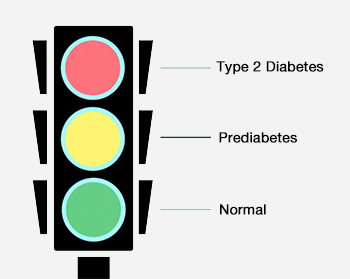Prediabetes is a condition where blood sugar levels are higher than normal, but not high enough to be diagnosed as type-2 diabetes. Prediabetes is not a disease, but rather a warning sign that your body is not processing glucose correctly and it is sometimes colloquially known as the “waiting room for diabetes”. If it is not diagnosed and managed, estimates are that between 26%-50% of prediabetics will deteriorate to diabetes within five years of their diagnosis[1].
Whilst the symptoms of prediabetes are blood sugar levels that are higher than normal, this can present itself in a number of different ways and a diagnosis is made if there are impaired fasting glucose levels (IFG), impaired glucose tolerance (IGT), or both. As the name suggests, impaired fasting glucose is when your blood glucose levels are higher than normal when you haven’t eaten anything within the past eight hours (diagnostic range is fasted blood sugar levels between 5.6-6.9mmol/L (100-125mg/dL)). With impaired glucose tolerance, your fasted blood sugar levels are within the normal range, but after eating, you have an abnormally high blood sugar response, and your sugar levels do not return to the normal range within two hours (diagnostic test is glucose levels between 7.8-11.1mmol/L (140-199mg/dL) two hours after 75g glucose tolerance test). Some prediabetics present with both IFG and IGT, and these individuals are twice as likely to develop diabetes[2].
Both IFG and IGT are insulin resistant states, but the site of insulin resistance differs. People with IGT are predominantly insulin resistant in their muscles but have normal or slightly reduced hepatic or liver insulin sensitivity, whilst the opposite occurs in IFG where there is normal muscle insulin sensitivity but are insulin resistant in their liver[2].
The International Diabetes Federation estimates that in 2021, more than 10% of adults worldwide have IGT (541 million people) whilst a further 319 million adults have IFG, meaning almost 900 million people are prediabetic. This is projected to rise to almost 1.2 billion people by 2045[3]. More than a third of prediabetics are under 45 years of age, and with the estimated progression rates, this represents a significant long-term burden to global health care systems.
Whilst prediabetes is not considered a disease, prediabetes is associated with an increased risk of many diseases. A systematic review and meta-analysis of prospective cohort studies involving more than 1.6 million individuals showed that there was an increased risk of cardiovascular disease, coronary heart disease, stroke, and all-cause mortality in prediabetics compared with people with normal blood sugar levels[4]. These are conditions are normally observed in diabetics but there is growing evidence demonstrating that prediabetics have concomitant damage to the eyes, kidneys, blood vessels and heart[5].
The good news is that prediabetes is ‘preVENTABLE diabetes’. There are numerous studies that show that prediabetes can be reversed and normoglycaemia restored[6-9]. Lifestyle interventions and pharmaceutical interventions have been used to reverse prediabetes, with lifestyle changes being shown to be the most effective method[10]. It is recommended that intervention is started as soon as possible to preserve beta-cell function, and the advantage with lifestyle interventions are there are no unwanted effects, but rather beneficial health effects. The recommendations are to reduce body weight (5-10% reduction) and increase physical activity to 30 minutes daily. Lifestyle changes are however difficult to make and so functional ingredients like Reducose® that can help support weight loss, reduce glucose excursions, support cardiovascular function and support healthy insulin responses would be beneficial to prediabetics.
- Richter, B., et al., Development of type 2 diabetes mellitus in people with intermediate hyperglycaemia. Cochrane Database Syst Rev, 2018. 10: p. CD012661.
- Nathan, D.M., et al., Impaired fasting glucose and impaired glucose tolerance: implications for care. Diabetes Care, 2007. 30(3): p. 753-9.
- IDF, IDF Diabetes Atlas – 10th edition, I.D. Federation, Editor. 2021.
- Huang, Y., et al., Association between prediabetes and risk of cardiovascular disease and all cause mortality: systematic review and meta-analysis. BMJ, 2016. 355: p. i5953.
- Tabak, A.G., et al., Prediabetes: a high-risk state for diabetes development. Lancet, 2012. 379(9833): p. 2279-90.
- Diabetes Prevention Program Research, G., et al., 10-year follow-up of diabetes incidence and weight loss in the Diabetes Prevention Program Outcomes Study. Lancet, 2009. 374(9702): p. 1677-86.
- Investigators, D.T., et al., Effect of rosiglitazone on the frequency of diabetes in patients with impaired glucose tolerance or impaired fasting glucose: a randomised controlled trial. Lancet, 2006. 368(9541): p. 1096-105.
- Ramachandran, A., et al., The Indian Diabetes Prevention Programme shows that lifestyle modification and metformin prevent type 2 diabetes in Asian Indian subjects with impaired glucose tolerance (IDPP-1). Diabetologia, 2006. 49(2): p. 289-97.
- Tuomilehto, J., et al., Prevention of type 2 diabetes mellitus by changes in lifestyle among subjects with impaired glucose tolerance. N Engl J Med, 2001. 344(18): p. 1343-50.
- Knowler, W.C., et al., Reduction in the incidence of type 2 diabetes with lifestyle intervention or metformin. N Engl J Med, 2002. 346(6): p. 393-403.


